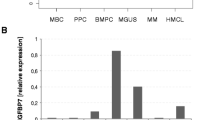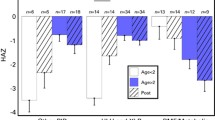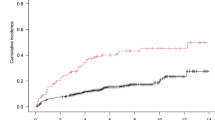Abstract
Insulin-like growth factor binding protein (IGFBP)-2 has mitogenic effects in normal and neoplastic cells. The purpose of this study is to examine the diagnostic and prognostic significance of elevated IGFBP-2 levels in children with AML after hematopoietic stem cell transplantation (HSCT) at relapse and continuous complete remission (CCR). In 27 children with AML (mean age 13.6±5.3 years; patients in remission n=15 with relapse n=12) serum parameters of IGFBP-2, IGFBP-3, IGF-I and IGF-II were analyzed up to 18 months after HSCT by RIA. AML-patients with evidence of relapse demonstrated a continuous increase of IGFBP-2 levels during the follow-up. At day 100 after HSCT, IGFBP-2 concentrations were significantly higher in patients with relapse than in children without relapse (7.4±4.0 standard deviation score (SDS) vs 3.9±1.7 SDS; P=0.01). Serum IGFBP-2 was identified as an independent factor for the prediction of relapse. Furthermore, the probability of relapse-free survival (RFS) in patients with IGFBP-2 >4.5 SDS at day 100 after HSCT was 31% compared to patients with IGFBP-2 <4.5 SDS was 72% (P=0.004). Patients with IGFBP-2 concentration up to 4.5 SDS more likely developed a relapse and had a poorer outcome. Identification of these patients allows a more individualized and aggressive adjuvant treatment and follow-up.


Similar content being viewed by others
References
Creuzig U, Ritter J, Zimmermann M, Reinhardt D, Hermann J, Berthold F et al. Improved treatment results in high-risk pediatric acute myeloid leukemia patients after intensification with high-dose cytarabine and mitoxantrone: results of Study Acute Myeloid Leukemia-Berlin-Frankfurt-Münster 93. J Clin Oncol 2001; 19: 2705–2713.
Ortega JJ, Diaz de Heredia C, Olive T, Bastida P, Llort A, Armadan L et al. Allogeneic and autologous bone marrow transplantation after consolidation therapy in high-risk acute myeloid leukemia in children. Towards a risk-oriented therapy. Haematologica 2003; 88: 290–299.
Woods WG, Neudorf S, Gold S, Sanders J, Buckley JD, Barnard DR et al. A comparison of allogeneic bone marrow transplantation, autologous bone marrow transplantation, and aggressive chemotherapy in children with acute myeloid leukemia in remission. Blood 2001; 97: 56–62.
Creutzig U, Ritter J, Zimmermann M, Schellong G . Does cranial irritation reduce the risk for bone marrow relapse in acute myelogenous leukemia? Unexpected results of childhood. AML Study-87. J Clin Oncol 1993; 11: 279–286.
Loeb DM, Arceci RJ . What is the optimal therapy for childhood AML? Oncology (Huntington) 2002; 16: 1057–1066; discussion 1066, 1068–1070.
Lanvers C, Reinhardt D, Dubbers A . Pharmacology of all-trans-retinoic acid in children with acute promyelocytic leukemia. Med Pediatr Oncol 2003; 40: 293–301.
Klein B, Tarte K, Jourdan M, Mathouk K, Moreaux J, Joudan E et al. Survival and proliferation factors of normal and malignant plasma cells. Int J Hematol 2003; 78: 106–113.
Busund LT, Richardsen E, Busund R, Ukkonem T, Bjornsen T, Busch C et al. Significant expression of IGFBP2 in breast cancer compared with benign lesions. J Clin Pathol 2005; 58: 361–366.
Kim HS, Ingermann AR, Tsubaki J, Twigg SM, Walker GF, Oh Y . Insulin-like growth factor-binding protein 3 induces caspase-dependent apoptosis through a death receptor-mediated pathway in MCF-7 human breast cancer cells. Cancer Res 2004; 64: 2229–2237.
Dupont J, Pierre A, Froment P, Moreau C . The insulin-like growth factor axis in cell cycle progression. Horm Metab Res 2003; 35: 740–750.
Drop SL, Schuller AG, Lindenbergh-Kortleve DJ, Groffen C, Brinkman A, Zwarthoff EC . Structural aspects of the IGFBP family. Growth Regul 1992; 2: 69–79.
Duan C, Xu Q . Roles of insulin-like growth factor (IGF) binding proteins in regulating IGF actions. Gen Comp Endocrinol 2005; 142: 44–52.
Yu H, Nicar MR, Shi R, Berkeltt J, Nam R, Trachtenberg J et al. Levels of insulin-like growth factor-I (IGF-I) and IGF-binding proteins -2 and -3 in serial postoperative serum samples and risk of prostate cancer recurrence. Urology 2001; 57: 471–475.
Elmlinger MW, Sanatani MS, Bell M, Dannecker GE, Ranke MB . Elevated insulin-like growth factor (IGF) binding protein (IGFBP)-2 and IGFBP-4 expression of leukemic T-cells is affected by autocrine/paracrine IGF-II action but not by IGF type I receptor expression. Eur J Endocrinol 1998; 138: 337–343.
Lee EJ, Mircean C, Shmulevich I, Wang H, Liu J, Niemisto A et al. Insulin-like growth factor binding protein 2 promotes ovarian cancer cell invasion. Mol Cancer 2005; 4: 7.
Dawczynski K, Kauf E, Zintl F . Changes of serum factors (IGF-I,-II and IGFBP-2,-3) prior to and after stem cell transplantation in children with acute leukemia. Bone Marrow Transplant 2003; 32: 411–415.
Blum WF, Breier BH . Radioimmunoassays for IGFs and IGFBPs. Growth Regul 1994; 4 (Suppl 1): 11–19.
Blum WF, Horn N, Kratzsch J, Jorgensen JO, Juul A, Teale D et al. Clinical studies of IGFBP-2 by radioimmunoassay. Growth Regul 1993; 3: 100–104.
Frystyk J, Ivarsen P, Stoving RK, Dall R, Bek T, Hagen C et al. Determination of free insulin-like growth factor-I in human serum: comparison of ultrafiltration and direct immunoradiometric assay. Growth Horm IGF Res 2001; 11: 117–127.
Cicognani A, Cacciari E, Pession A, Passini A, De Jasio R, Gennai M et al. Insulin-like growth factor-I (IGF-I) and IGF-binding protein-3 (IGFBP-3) concentration compared to stimulated growth hormone (GH) in the evaluation of children treated for malignancy. J Pediatr Endocrinol Metab 1999; 12: 629–638.
Dorbyski WR . The role of allogeneic transplantation in high–risk acute myelogenous leukemia. Leukemia 2004; 18: 1565–1568.
Knechtli CJ, Goulden NJ, Hancock JH, Harris EL, Garland RJ, Jones CG et al. Minimal residual disease status as a predictor of relapse after allogeneic bone marrow transplantation for children with acute lymphoblastic leukaemia. Br J Haematol 1998; 102: 860–871.
Sakatani T, Shimazaki C, Hirai H, Okano A, Hatsuse M, Okamoto A et al. Early relapse after high-dose chemotherapy rescued by tumor-free autologous peripheral blood stem cells in acute lymphoblastic leukemia: importance of monitoring of WT1 mRNA quantitatively. Leuk Lymphoma 2001; 42: 225–229.
Dolmen G . Detection of minimal residual disease. Adv Cancer Res 2001; 82: 133–185.
Ho PJ, Baxter RC . Insulin-like growth factor-binding protein-2 in patients with prostate carcinoma and benign prostatic hyperplasia. Clin Endocrinol 1997; 46: 333–342.
Boulle N, Logie A, Gicquel C, Perin L, Le Bouc Y . Increased levels of insulin-like growth factor II (IGF-II) and IGF-binding protein-2 are associated with malignancy in sporadic adrenocortical tumors. J Clin Endocrinol Metab 1998; 83: 1713–1720.
Petridou E, Skalkidou A, Dessypris N, Moustaki M, Mantzoros C, Spanos E et al. Insulin-like growth factor binding protein-3 predicts survival from acute childhood leukemia. Oncology 2001; 60: 252–257.
Batron-Hay S, Boyle F, Ferrier A, Scott C . Elevated serum insulin-like growth factor binding protein-2 as a prognostic marker in patients with ovarian cancer. Clin Cancer Res 2004; 10: 1796–1806.
Vorwerk P, Wex H, Hohmann B, Mohnike K, Schmidt U, Mittler U . Expression of components of the IGF signalling in childhood acute lymphoblastic leukaemia. Mol Pathol 2002; 55: 40–45.
Cianfarani S, Rossi P . Neuroblastoma and insulin-like growth factor system. New insights and clinical perspectives. Eur J Pediatr 1997; 156: 256–261.
Menouny M, Binox M, Babajako S . IGFBP-2 expression in a human cell line is associated with increased IGFBP-3 proteolysis, decrease IGFBP-1 expression and increased tumorgenicity. Int J Cancer 1998; 77: 874–879.
Hettmer S, Dannecker L, Foell J, Elmlinger MW, Dannecker GE . Effects of insulin-like growth factors and insulin-like growth factor binding protein-2 on the in vitro proliferation of peripheral blood mononuclear cells. Hum Immunol 2005; 66: 95–103.
Elmlinger MW, Sanatani MS, Bell M, Dannecker GE, Ranke MB . Elevated insulin-like growth factor (IGF) binding protein (IGFBP)-2 and IGFBp-4 expression of leukemic T-cells is affected by autocrine/paracrine IGF-II action but not by IGF type I receptor expression. Eur J Endocrinol 1998; 138: 337–343.
Vorwerk P, Mohnike K, Wex H, Rohl FW, Zimmermann M, Blum WF et al. Insulin-like growth factor binding protein-2 at diagnosis of childhood acute lymphoblastic leukaemia and the prediction of relapse risk. J Clin Endocrinol Metab 2005; 90: 3022–3027.
Bugie-Barhim S, Min HK, Oh Y . Potential of proteomics towards the investigation of the IGF-independent actions of IGFBP-3. Expert Rev Proteom 2005; 2: 71–86.
Schutt BS, Langkamp M, Rauschnabel U, Ranke MB, Elmlinger MW . Integrin-mediated action of insulin-like growth factor binding protein-2 in tumor cells. J Mol Endocrinol 2004; 32: 859–868.
Taya S, Inagaki N, Sengiku H, Makino H, Iwanatsu A, Urakawa I et al. Direct interaction of insulin-like growth factor-1 receptor with leukemia-associated RhoGEF. J Cell Biol 2001; 155: 809–820.
Munker R, Salat C, Pihusch R, Diem H, Hiller E, Glass J et al. Levels of insulin-like growth factor after stem cell transplantation. Eur J Med Res 2001; 6: 181–184.
Author information
Authors and Affiliations
Corresponding author
Rights and permissions
About this article
Cite this article
Dawczynski, K., Kauf, E., Schlenvoigt, D. et al. Elevated serum insulin-like growth factor binding protein-2 is associated with a high relapse risk after hematopoietic stem cell transplantation in childhood AML. Bone Marrow Transplant 37, 589–594 (2006). https://doi.org/10.1038/sj.bmt.1705281
Received:
Revised:
Accepted:
Published:
Issue Date:
DOI: https://doi.org/10.1038/sj.bmt.1705281
- Springer Nature Limited
Keywords
This article is cited by
-
Obesity and Leukemia: Biological Mechanisms, Perspectives, and Challenges
Current Obesity Reports (2023)
-
Diet and exercise interventions for pediatric cancer patients during therapy: tipping the scales for better outcomes
Pediatric Research (2018)
-
IGF-binding protein 2 is a candidate target of therapeutic potential in cancer
Tumor Biology (2016)
-
IGFBP-2 - taking the lead in growth, metabolism and cancer
Journal of Cell Communication and Signaling (2015)
-
IGF binding protein 2 is a cell-autonomous factor supporting survival and migration of acute leukemia cells
Journal of Hematology & Oncology (2013)




